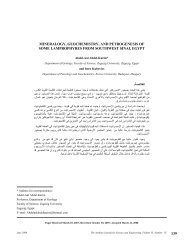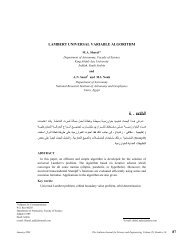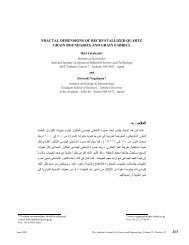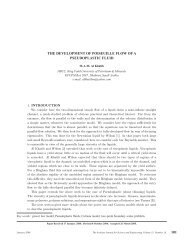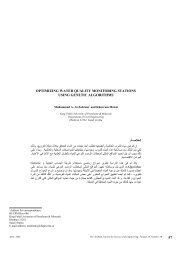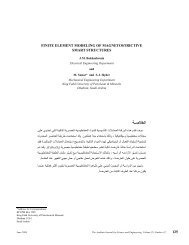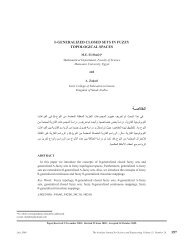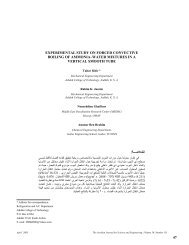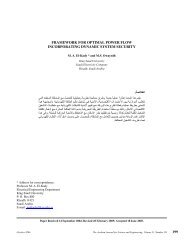اﻟﺨﻼﺻــﺔ - Arabian Journal for Science and Engineering
اﻟﺨﻼﺻــﺔ - Arabian Journal for Science and Engineering
اﻟﺨﻼﺻــﺔ - Arabian Journal for Science and Engineering
Create successful ePaper yourself
Turn your PDF publications into a flip-book with our unique Google optimized e-Paper software.
،سﺎﺤﻨﻟاو<br />
مﻮﻴﺸﻥاﺮﺘﺱﻻاو<br />
LEVELS OF TRACE ELEMENTS IN DIFFERENT<br />
VARIETIES OF WHEAT DETERMINED BY ATOMIC<br />
ABSORPTION SPECTROSCOPY<br />
،موﺮﻜﻟاو<br />
،ﺖﻠﺏﻮﻜﻟاو<br />
،صﺎﺻﺮﻟاو<br />
A.E. Mohamed* <strong>and</strong> G.M. Taha<br />
Chemistry Department, Faculty of <strong>Science</strong><br />
Aswan, Egypt<br />
،مﻮﻴﺴﻟﺎﻜﻟاو<br />
،ﻞﻜﻴﻨﻟاو<br />
،ﺐهﺬﻟاو<br />
،مﻮﻳدﻮﺼﻟاو<br />
،ﺔﻀﻔﻟا ﺮﺻﺎﻨﻋ ﺮﻳﺪﻘـﺘﺏ<br />
،ﺰﻴﻨﺠﻨﻤﻟاو<br />
،مﻮﻴﺴﻨﻏﺎﻤﻟاو<br />
ﺔــﺻﻼﺨﻟا<br />
اﺬه ﻰﻨﻌُﻳ<br />
July 2003 The <strong>Arabian</strong> <strong>Journal</strong> <strong>for</strong> <strong>Science</strong> <strong>and</strong> <strong>Engineering</strong>, Volume 28, Number 2A. 163<br />
ﺚﺤﺒﻟا<br />
،مﻮﻴﺱﺎﺕﻮﺒﻟاو<br />
،ﺪﻳﺪﺤﻟاو<br />
ﺔﻔﻠﺘﺨﻡ لود ﻦﻡ<br />
تﺬﺥأ ﻲﺘﻟا ﺢﻤﻘﻟا تﺎﻨﻴﻋ ﺾﻌﺏ ﻰﻓ يرﺬﻟا<br />
صﺎﺼﺘﻡﻻا فﺎﻴﻄﻡ ماﺪﺨﺘﺱﺎﺏ<br />
ﻦﻴﺻرﺎﺨﻟاو<br />
ﻢﺕ ﺪﻗو . ﻦﻤﻴﻟاو ،ةﺪﺤﺘﻤﻟا<br />
ﺔﻴﺑﺮﻌﻟا تارﺎﻣﻹاو<br />
،نﺎﻤﻋو<br />
،ﺎﻴﻟاﺮﺘﺱاو<br />
،ﺔﻳدﻮﻌﺴﻟا ﺔﻴﺏﺮﻌﻟا ﺔﻜﻠﻤﻤﻟاو<br />
،ﺮﺼﻡ ﻰه<br />
تﺎﻨﻴﻌﻟا ﻰﻓ ﺮﺻﺎﻨﻌﻟا ﻩﺬه تاﺰﻴآﺮﺕ ﻰﻓ فﻼﺘﺥا<br />
ﺞﺋﺎﺘﻨﻟا تﺮﻬﻇﺄﻓ<br />
،ﺔﺡﻮﺘﻔﻤﻟا قاﻮﺱﻷا ﻦﻡ تﺎﻨﻴﻌﻟا ﻊﻴﻤﺠﺕ<br />
ﺞﺋﺎﺘﻨﻟا تﺮﻬﻇأ ﺎﻤآ . لوﺪﻟا ﻩﺬه ﻰﻓ ﺎﻬﺒﻴآﺮﺕو<br />
ﺔﺏﺮﺘﻟا ﺔﻴﻋﻮﻥ ﻰﻓ فﻼﺘﺥﻻا ﻰﻟإ اﺬه دﻮﻌﻳ ﺪﻗو . ﺔﻔﻠﺘﺨﻤﻟا<br />
ﺾﻌﺏ تاﺰﻴآﺮﺕ ﻲﻓ برﺎﻘﺕ دﻮﺝوو ،ﺔﻀﻔﻟا<br />
ﺮﺼﻨﻋ اﺪﻋ ﺎﻡ ﺔﻳﺮﺼﻤﻟا ﺔﻨﻴﻌﻟا ﻰﻓ ﺮﺻﺎﻨﻌﻟا ﻞآ دﻮﺝو<br />
لوﺪﻟا ﻩﺬه ﻰﻓ ﺔﺏﺮﺘﻠﻟ ﻲﻥﺪﻌﻤﻟا ﺐﻴآﺮﺘﻟا نأ ﻰﻠﻋ لﺪﻳ اﺬهو . ﻦﻤﻴﻟاو تارﺎﻣﻹا ،نﺎﻤﻋ<br />
تﺎﻨﻴﻋ ﻰﻓ ﺮﺻﺎﻨﻌﻟا<br />
. ًﺎﻴﻟود ﺎﻬﺏ حﻮﻤﺴﻤﻟا دوﺪﺤﻟا ﻦﻤﺽ ﻊﻘﺕ<br />
ﺮﺻﺎﻨﻌﻟا ﻩﺬه تاﺰﻴآﺮﺕ نأ ﺔﺱارﺪﻟا ﺖﺤﺽوأو . ﻪﺏﺎﺸﺘﻡ<br />
*To whom correspondence should be addressed.<br />
e-mail: gmtaha@hotmail.com
A.E. Mohamed <strong>and</strong> G.M. Taha<br />
ABSTRACT<br />
Trace elements, Ag, Au, Ca, Co, Cr, Cu, Fe, K, Mg, Mn, Na, Ni, Pb, Sr, <strong>and</strong> Zn were<br />
determined in six wheat samples purchased from the open market in different localities<br />
(Egypt, Saudi Arabia, (KSA), Yemen, Oman, Dubai, <strong>and</strong> Australia). The dried<br />
powdered samples were decomposed in HNO3 –HClO4 acids mixture <strong>and</strong> elements<br />
were determined using recording atomic absorption spectrophotometer. The results<br />
were within the safety baseline of all the assayed elements. Certified biological<br />
st<strong>and</strong>ards, Bown’s Kale (BK), Orchard Leaves (OL), <strong>and</strong> Tomato Leaves (TOML)<br />
were used to ensure the accuracy of the results. However, Co, Pb, <strong>and</strong> Sr were<br />
absent from samples except the Egyptian samples. The obtained databases were<br />
statistically treated. Several significant <strong>and</strong> strong positive correlation coefficients<br />
(r = 0.506–1.00) between the groups of elements were observed. On the other h<strong>and</strong>,<br />
strong negative correlations (r = –0.492 to –0.873) between another group of elements<br />
were also shown.<br />
Keywords: Wheat samples, Trace elements, Atomic absorption Spectroscopy.<br />
164 The <strong>Arabian</strong> <strong>Journal</strong> <strong>for</strong> <strong>Science</strong> <strong>and</strong> <strong>Engineering</strong>, Volume 28, Number 2A. July 2003
A.E. Mohamed <strong>and</strong> G.M. Taha<br />
LEVELS OF TRACE ELEMENTS IN DIFFERENT VARIETIES OF WHEAT<br />
DETERMINED BY ATOMIC ABSORPTION SPECTROSCOPY<br />
1. INTRODUCTION<br />
Trace elements play a very important role in chemical, biochemical, physiological, metabolic, geochemical,<br />
biogeochemical, <strong>and</strong> enzymatic processes. Consequently, their importance is pronounced on the health <strong>and</strong> diseases of<br />
plants, animals, <strong>and</strong> human being, as they are dependent on trace elements needed from food.<br />
Trace elements present in plants to a great extent depend on the available <strong>and</strong> exchangeable trace elements present in<br />
the soil, <strong>and</strong> in irrigation water. However, there is permissibility <strong>and</strong> selectivity in plants <strong>for</strong> the uptake of certain trace<br />
elements (essential) from the soil, but there are other useful trace elements which accelerate, stunt, or inhibit such uptake.<br />
The importance of trace element analysis in environmental, biological, geological, geochemical, biogeochemical,<br />
industrial, <strong>and</strong> in many other fields is well known. There are several methods available <strong>for</strong> the determination of trace<br />
elements in these matrixes.<br />
Various developments in agriculture <strong>and</strong> technology can affect the trace elements content of foods. The introduction of<br />
new varieties of plants, the use of agricultural chemicals, alterations in feeding practices used <strong>for</strong> farm animals, <strong>and</strong> other<br />
new techniques designed to increase food production <strong>and</strong> yields affect the composition of basic food items [1].<br />
Three major factors influence the amount of trace elements in food as consumed: (i) inherent characteristics of plants<br />
<strong>and</strong> animals; (ii) environmental conditions affecting plants <strong>and</strong> animals; <strong>and</strong> (iii) methods <strong>for</strong> h<strong>and</strong>ling <strong>and</strong> processing of<br />
the plant <strong>and</strong> animal material.<br />
Geographical Location<br />
Differences due to geographical location probably depend on contamination of water, air or soil with the trace<br />
elements. Variations observed in the selenium content of foods grown in Sweden, Egypt, <strong>and</strong> the USA are a good<br />
example of how geographical location significantly affects the trace elements contents of foods.<br />
Foods from Sweden <strong>and</strong> Egypt have been reported [2, 3] to have rather a low selenium content as compared with the<br />
levels found [4, 5] in the USA. Also, it was found that [6] the amounts of copper in spinach <strong>and</strong> lettuce depend on the<br />
quantity <strong>and</strong> availability of the trace element in the soil. Atomic absorption spectrophotometry has been used [7, 8] to<br />
determine the trace elements in plants <strong>and</strong> vegetables [9] of Lake Nasser. Inductively coupled plasma atomic emission<br />
spectrophotometry has been utilized to determine the trace elements Be, Ca, Cr, Fe, Pb, <strong>and</strong> Zn in raw agricultural crops<br />
(lettuce, potatoes, spinach, <strong>and</strong> wheat) [10]. Multielemental neutron activation analysis techniques have been applied<br />
[11, 12] <strong>for</strong> the determination of Al, As, Au, La, Mo, <strong>and</strong> Zn in Egyptian crops.<br />
The present work is aimed to introduce unprecedented monitoring of the analyzed wheat samples. In addition,<br />
comparison between the elemental content of the different varieties of wheat samples from different locations globally<br />
represent an important target of this work. The work is also done to establish the extent to which the elements present in<br />
the different varieties of wheat are present at safe levels.<br />
2. EXPERIMENTAL<br />
Chemical <strong>and</strong> Reagents<br />
All chemicals used were of A.R. grade (99.9 %) <strong>and</strong> purchased from BDH, Aldrich, Sigma, or E. Merck.<br />
Certified ASS st<strong>and</strong>ard solutions (1 mg/ml) of Ag, Au, Ca, Cd, Co, Cu, Fe, Mg, Mn, Ni, Pb, Sr, <strong>and</strong> Zn were<br />
purchased from BDH (UK). Working st<strong>and</strong>ard solutions were prepared by appropriate dilution of the stock solutions.<br />
Biological st<strong>and</strong>ards [13] (Bown’s Kale “BK”, Orchard Leaves “OL”, as well as Tomato Leaves “TOML”) were used to<br />
check the accuracy of the results.<br />
July 2003 The <strong>Arabian</strong> <strong>Journal</strong> <strong>for</strong> <strong>Science</strong> <strong>and</strong> <strong>Engineering</strong>, Volume 28, Number 2A. 165
A.E. Mohamed <strong>and</strong> G.M. Taha<br />
Sample Collection<br />
Six species of wheat samples (two groups of each sample) were collected from the open markets from six locations<br />
(Egypt, Saudi Arabia, Yemen, Oman, Dubai, <strong>and</strong> Australia).<br />
Analytical Determination<br />
Representative wheat samples prepared by the quartering method were powdered in an agate mortar <strong>and</strong> kept in<br />
polyethylene bottles. Wheat samples (4g) were wet ashed in a Teflon beaker using 40 ml 1:1 v/v mixture of<br />
HNO3–HClO4 acids, followed by the addition of three drops of HF acid. The contents were evaporated on a s<strong>and</strong> bath<br />
near to dryness. The residue was cooled, dissolved in 5 ml conc. HCl, <strong>and</strong> made up to 100 ml using thrice distilled water.<br />
The resulting clear solutions were then used <strong>for</strong> chemical analysis.<br />
Equipment<br />
A SP 1900 Pye Unicam recording flame atomic absorption spectrophotometer was used <strong>for</strong> these measurements.<br />
3. RESULTS AND DISCUSSION<br />
The results obtained from the analysis of the wheat samples are listed in Table 1. The statistical analysis of the<br />
obtained data is tabulated in Table 2.<br />
Table 1. Mean Concentration of Trace Elements in Some Varieties of Wheat Samples Determined by AAS.<br />
Metal<br />
Concentration<br />
Country<br />
Egypt KSA Australia Oman Dubai Yemen<br />
Ag (ppb) - 2.01 - 3.19 1.90 -<br />
Au (ppb) 12.53 7.90 1.90 4.00 3.99 1.97<br />
Ca (ppm) 260 24.50 7.01 7.02 4.12 7.46<br />
Co (ppb) 12.2 - - - - -<br />
Cr (ppb) 12.8 - 7.00 - - 8.00<br />
Cu (ppm) 0.14 0.34 0.16 0.23 0.16 0.17<br />
Fe (ppm) 1.45 4.46 8.00 7.55 6.30 13.00<br />
K (ppm) 126 114 87 103 108 93<br />
Mg (ppm) 29.00 15.50 15.13 15.40 14.72 15.10<br />
Mn (ppm) 0.86 1.00 0.80 0.77 0.57 0.81<br />
Na (ppm) 2.02 4.98 10.7 4.0 4.5 11.9<br />
Ni (ppb) 0.72 0.38 0.51 0.59 0.33 0.73<br />
Pb (ppb) 11.50 - - - - -<br />
Sr (ppb) 26.90 - - - - -<br />
Zn (ppm) 0.46 1.60 0.91 0.94 0.61 0.93<br />
166 The <strong>Arabian</strong> <strong>Journal</strong> <strong>for</strong> <strong>Science</strong> <strong>and</strong> <strong>Engineering</strong>, Volume 28, Number 2A. July 2003
Silver.<br />
A.E. Mohamed <strong>and</strong> G.M. Taha<br />
Table 2. Statistical Factors Calculated from the Data of the Assayed Elements Present in the Wheat Samples.<br />
Element Samples Mean Medium SD SE Min Max<br />
Ag 6 0.0012 0.001 0.0013 0.0005 0.00 0.003<br />
Au 6 0.0053 0.004 0.0039 0.0016 0.0018 0.012<br />
Ca 6 53.30 7.30 106.4 4.34 4.10 270.0<br />
Co 6 0.0022 0.00 0.0053 0.002 0.00 0.013<br />
Cr 6 2.39 0.01 3.74 1.53 0.00 0.0126<br />
Cu 6 0.192 0.162 0.073 0.0297 0.13 0.33<br />
Fe 6 6.81 6.89 3.90 1.59 1.50 13.13<br />
K 6 105.50 107.0 14.84 6.06 86.0 123.0<br />
Mg 6 17.48 15.26 5.65 2.31 14.70 29.0<br />
Mn 6 0.792 0.79 0.15 0.062 0.55 1.02<br />
Na 6 6.65 4.95 4.23 1.73 2.00 12.50<br />
Ni 6 0.53 0.54 0.17 0.068 0.33 0.71<br />
Pb 6 0.002 0.00 0.005 0.002 0.00 0.012<br />
Sr 6 0.0045 0.00 0.011 0.004 0.00 0.027<br />
Zn 6 0.888 0.900 0.383 0.156 0.46 1.57<br />
SD = st<strong>and</strong>ard deviation; SE = statistical error; Min = minimum value; Max = maximum value.<br />
The mean concentration of silver present in the samples collected from Egypt, Saudi Arabia (KSA), Yemen, Oman,<br />
Dubai, <strong>and</strong> Australia are 0.00, 0.002, 0.00, 0.0033, 0.0018, <strong>and</strong> 0.00 µg/g, respectively. It is clear that only the wheat<br />
samples from the Asian continent contain silver. That may be related to the geographical location, which gives specific<br />
characteristics to water, air, <strong>and</strong> soil of this area. The order of the assayed silver is Oman > KSA > Dubai > Egypt =<br />
Yemen = Australia.<br />
Gold.<br />
The wheat samples collected from different localities (i.e., Egypt, KSA, Yemen, Oman, Dubai, <strong>and</strong> Australia) show<br />
mean gold concentrations of 0.0125, 0.008, 0.002, 0.004, 0.004, <strong>and</strong> 0.0018 µg/g, respectively. The order of gold<br />
concentrations in the samples under study is: Egypt > KSA > Oman = Dubai > Yemen > Australia. That Egyptian wheat<br />
samples contain the highest gold concentration may be related to the geological characteristics of Egyptian soil.<br />
Calcium.<br />
The assayed calcium concentrations in the wheat samples of Egypt, KSA, Yemen, Oman, Dubai, <strong>and</strong> Australia are:<br />
270, 24.25, 7.50, 7.01, 4.10, <strong>and</strong> 7.00 µg/g, respectively. It is obvious that the order of calcium concentration is<br />
Egypt > KSA > Yemen > Oman > Australia > Dubai. The highest level of calcium in Egyptian wheat samples may be<br />
due to the nature of Egyptian soil, irrigation water, <strong>and</strong> kind of fertilization.<br />
Calcium is an essential constituent of the middle lamellae of the cell walls. It activates a number of enzymes including<br />
α-amylase <strong>and</strong> plays an important role in nitrogen metabolism.<br />
July 2003 The <strong>Arabian</strong> <strong>Journal</strong> <strong>for</strong> <strong>Science</strong> <strong>and</strong> <strong>Engineering</strong>, Volume 28, Number 2A. 167
A.E. Mohamed <strong>and</strong> G.M. Taha<br />
Cobalt.<br />
A part from the Egyptian wheat samples all the others are free from cobalt. This may be due to either the actual<br />
absence of cobalt in these samples or the presence of cobalt under its detection limit. 0.0126 µg/g is the mean cobalt<br />
concentration evaluated in the Egyptian wheat samples. The presence of cobalt in wheat samples which collected from<br />
Egypt may be due to the characteristics of the Egyptian soil.<br />
Cobalt is an essential nutrient activator involving vitamin B12 synthesis <strong>and</strong> nitrogen fixation [14]. Cobalt coordinates<br />
with carboxy peptidase enzymes <strong>and</strong> catalyzes amino acids. Deficiency of cobalt results in [15] poor growth, break down<br />
of the healthy parts of the lamina <strong>and</strong> chlorosis.<br />
Chromium.<br />
The mean concentrations of chromium in the wheat samples collected from Egypt, Yemen, <strong>and</strong> Australia are: 0.0126,<br />
0.0081, <strong>and</strong> 0.0062 µg/g, respectively. On the other h<strong>and</strong>, 0.00 µg/g chromium is the level which is present in the KSA,<br />
Oman, <strong>and</strong> Dubai wheat samples. That is may be due to either the absence of chromium in these samples or its presence<br />
under the detection limit.<br />
Chromium is considered [15] to be an essential micronutrient element <strong>and</strong> necessary <strong>for</strong> increasing the rate of plant<br />
growth.<br />
Copper.<br />
Wheat samples collected from Egypt, KSA, Yemen, Oman, Dubai, <strong>and</strong> Australia show mean copper concentrations of<br />
0.13, 0.33, 0.17, 0.21, 0.15, <strong>and</strong> 0.16 µg/g, respectively. It is clear that the order of the presence of copper in the samples<br />
is: KSA > Oman > Yemen > Australia > Dubai > Egypt. The source of copper in all samples studied may be related to<br />
the nature of soil <strong>and</strong> the surrounding environment in which the wheat samples are planted.<br />
Copper is an important essential nutrient <strong>and</strong> <strong>for</strong>ms a number of copper proteins. The presence of copper may reflect<br />
[16] its usefulness in the plant growth <strong>and</strong> may give the greenish–olive color. It is a constituent of ascorbic acid oxidase,<br />
lactose, <strong>and</strong> tyrosinase enzymes.<br />
Iron.<br />
The results of the analysis of six replicates of wheat samples show the mean iron concentrations of: Egypt: 1.50 µg/g,<br />
KSA: 4.45 µg/g, Yemen: 13.13 µg/g, Oman: 7.53 µg/g, Dubai: 6.25 µg/g, <strong>and</strong> Australia: 7.99 µg/g. Hence, the order of<br />
the iron magnitude is Yemen > Australia > Oman > Dubai > KSA > Egypt.<br />
Iron is an essential nutrient activator involving vitamin B12 synthesis <strong>and</strong> nitrogen fixation. Iron <strong>for</strong>ms a number of<br />
iron proteins. Iron deficiency results in chlorosis [17].<br />
Potassium.<br />
The mean potassium concentrations of 123, 118, 92, 101, 113, <strong>and</strong> 86 µg/g are estimated in the wheat samples<br />
collected from Egypt, KSA, Yemen, Oman, Dubai, <strong>and</strong> Australia, respectively.<br />
The order of the estimated potassium is: Egypt > KSA > Dubai > Oman > Yemen > Australia. It is well known that,<br />
the Egyptian soil is rich in potassium. As a result, the Egyptian wheat samples have the highest value of potassium<br />
among all the wheat samples analyzed. On the other h<strong>and</strong>, the highest potassium value in the Egyptian samples may be<br />
related to the kind of fertilization used in Egypt.<br />
Potassium is an essential nutrient element <strong>and</strong> present in plant tissues entirely as the potassium ion. It has an important<br />
role in amino acids <strong>and</strong> proteins synthesis from ammonium ions, <strong>and</strong> the <strong>for</strong>mation of internodes is related to its role.<br />
It activates the enzymatic reactions of carbohydrate metabolism. It regulates the osmotic pressure of extracellular fluids<br />
<strong>and</strong> the acid–base balance. Potassium deficiency decreases the rate of amino acids synthesis <strong>and</strong> results in a low level of<br />
protein, in weakening, chlorosis, <strong>and</strong> rolling of leaves, shortening of internodes <strong>and</strong> stunts the plant growth [18].<br />
168 The <strong>Arabian</strong> <strong>Journal</strong> <strong>for</strong> <strong>Science</strong> <strong>and</strong> <strong>Engineering</strong>, Volume 28, Number 2A. July 2003
Magnesium.<br />
A.E. Mohamed <strong>and</strong> G.M. Taha<br />
The mean magnesium concentrations of 29.00, 15.54, 15.18, 15.30, 14.70, <strong>and</strong> 15.17 µg/g are determined in the wheat<br />
samples collected from Egypt, KSA, Yemen, Oman, Dubai, <strong>and</strong> Australia, respectively. The determined values are<br />
ordered as: Egypt > Oman > Yemen > Australia > Dubai. The highest value of magnesium in the Egyptian wheat sample<br />
may be attributed to the high value of magnesium in the Egyptian soil.<br />
Magnesium is an essential nutrient element. It activates numerous enzymes <strong>and</strong> plays a significant role in the<br />
photosynthesis, nucleic acid synthesis from nucleotide polyphosphates, dehydrogenation, carboxylase, carbohydrate<br />
metabolism, <strong>and</strong> respiration by regulating phosphate metabolism <strong>and</strong> acts as a binding agent in the ribosomal particles.<br />
Deficiency of magnesium results in the development of a characteristic chlorosis <strong>and</strong> in some species in the appearance<br />
of a purple coloration in the foliage. Magnesium <strong>and</strong> calcium act as binding agents to fuse the walls of the plant cells<br />
together [16–18].<br />
Manganese.<br />
The tabulated results show that mean manganese concentrations of 0.84, 1.02, 0.80, 0.76, 0.55, <strong>and</strong> 0.78 µg/g are<br />
determined in the wheat samples collected from Egypt, KSA, Yemen, Oman, Dubai, <strong>and</strong> Australia, respectively. The<br />
results indicate that the manganese concentration is in the order: KSA > Egypt >Yemen > Australia > Oman > Dubai.<br />
Manganese is an essential nutrient element. It plays an important role in plant metabolism. It serves also as metal<br />
co-factor <strong>for</strong> activating enzymes such as hydrolases, kinases, decarboxylases, <strong>and</strong> transferases, in addition to being<br />
intimately involved with the synthesis of fatty acids, glycoprotein, DNA <strong>and</strong> RNA, <strong>and</strong> cholesterol from acetate. Taste<br />
<strong>and</strong> color may be attributed to the existence of manganese. Deficiency in manganese causes [15, 16, 18] diseases such as<br />
grey speck of oats <strong>and</strong> speckled yellow in beet.<br />
Sodium.<br />
The results of the analysis of the wheat samples collected from Egypt, KSA, Yemen, Oman, Dubai, <strong>and</strong> Australia,<br />
exhibit a mean sodium concentration of 2.00, 5.30, 12.50, 4.20, 4.60, <strong>and</strong> 11.30 µg/g, respectively. The assayed<br />
magnitudes of sodium ion are of the order of: Yemen > Australia > KSA > Dubai > Oman > Egypt. Certainly, the<br />
highest value of sodium in the Yemen wheat samples is related to the nature of its soil.<br />
Sodium is an essential element <strong>for</strong> plants. It has a catalytic effect on enzymes activity <strong>and</strong> its major function is as<br />
osmotic pressure regulator <strong>and</strong> in acid–base balance. It has also some definite function in the growth of the roots of some<br />
seeding plants. It is one of the major electrolytes in all extracellular fluids. Also, sodium is needed [15, 16, 18] in<br />
vegetables <strong>and</strong> fruit <strong>for</strong> glycolsis.<br />
Nickel.<br />
The data shown in Table 1 indicates that the wheat samples collected from Egypt, KSA, Yemen, Oman, Dubai, <strong>and</strong><br />
Australia have mean concentrations of nickel ion of: 0.71, 0.35, 0.71, 0.57, 0.33, <strong>and</strong> 0.51 µg/g, respectively.<br />
It is found that the mean concentrations are ordered as: Egypt = Yemen > Oman > Australia > KSA > Dubai.<br />
The highest magnitude of nickel in the wheat samples of both Egypt <strong>and</strong> Yemen may be attributed to the nature of the<br />
soil texture in both countries.<br />
Nickel, like other metals in the first transition series of the periodic table, may play an essential physiological role.<br />
Evidence of possible nickel essentiality is that nickel is consistently present in ribonucleic acid (RNA) from diverse<br />
sources in concentrations many times higher than in the native material from which the RNA is isolated.<br />
Lead.<br />
A part from the wheat samples collected from Egypt, all the other samples analyzed are free from lead. The mean lead<br />
concentration assayed in the Egyptian samples is 0.12 µg/g. This value of lead is under its safety baseline. Presence of<br />
July 2003 The <strong>Arabian</strong> <strong>Journal</strong> <strong>for</strong> <strong>Science</strong> <strong>and</strong> <strong>Engineering</strong>, Volume 28, Number 2A. 169
A.E. Mohamed <strong>and</strong> G.M. Taha<br />
lead in the Egyptian wheat samples may be related to its high natural abundance in air, soil, <strong>and</strong> in granitic rocks, which<br />
are abundant in Egypt. Many plants will tolerate high levels, but some show retarded growth at mg/g in solution-culture<br />
studies.<br />
Strontium.<br />
Strontium was only found in the Egyptian wheat samples, at a level of 27.0 µg/g.<br />
The absorption of strontium by plants is of importance due to [18] the presence of the long-lived radio-active isotope,<br />
Sr 90 , in the atmospheric fallout from thermonuclear explosions.<br />
Zinc.<br />
Based on the results in Table 1, the mean concentrations of zinc are: 0.46, 1.57, 0.90, 0.60, <strong>and</strong> 0.90 mg/g in wheat<br />
samples of Egypt, KSA, Yemen, Oman, Dubai, <strong>and</strong> Australia, respectively. Zinc values are ordered as KSA > Yemen =<br />
Oman = Australia > Dubai > Egypt.<br />
Zinc ion is an essential micronutrient element <strong>and</strong> cofactor in a number of enzyme systems. It has an important role<br />
[17] in cell replication <strong>and</strong> <strong>for</strong> the alteration of genetic potential in cell proliferation <strong>and</strong> labialization of lysosomal<br />
membrane in plant tissue.<br />
Statistical Analysis<br />
Statistical analysis of the data of wheat samples shows significant <strong>and</strong> positive correlation coefficient values<br />
(r = 0.506–1.00) <strong>and</strong> negative correlation coefficient values (r = 0.492–0.873). From the positive correlation coefficient<br />
values, it is evident that there are good interrelationships between the trace elements present in wheat <strong>and</strong> it is suggested<br />
that they perhaps exist as essential elements in the interstitial spaces <strong>and</strong> as mixed metal-high molecular weight<br />
complexes, chlorophyll, carbohydrate, humate, amino acid, vitamin, etc. in the plant cells, <strong>and</strong> they are important <strong>for</strong><br />
growth, pigmentation, taste, <strong>and</strong> fruiting.<br />
On the other h<strong>and</strong>, negative correlation coefficient values may be due to disproportionation, interlocking, <strong>and</strong><br />
counteraction between pairs of elements.<br />
4. CONCLUSION<br />
Based on the results obtained from the chemical analysis of some wheat samples collected from Egypt, KSA, Yemen,<br />
Oman, Dubai, <strong>and</strong> Australia, the following is concluded.<br />
First of all, <strong>and</strong> based on the safety baseline of the elements [20], all the assayed elements in all the analyzed wheat<br />
samples are either below (in most cases) or within their safety baseline.<br />
Cobalt, lead, <strong>and</strong> strontium ions were present only in the wheat samples which were collected from Egypt. Egypt has<br />
the highest values of gold, calcium, chromium, <strong>and</strong> magnesium ions, whereas, the lowest values of gold, calcium,<br />
chromium, <strong>and</strong> magnesium ions were determined in the wheat samples collected from Australia, Dubai, <strong>and</strong> Yemen,<br />
respectively. However, the lowest values of copper, sodium, iron, <strong>and</strong> zinc ions were assayed in the Egyptian wheat<br />
samples. KSA <strong>and</strong> Yemen wheat samples have the highest values of copper sodium, iron, <strong>and</strong> zinc ions, respectively.<br />
For potassium, the highest value is determined in the Egyptian wheat samples <strong>and</strong> the lowest value in the Australian<br />
wheat samples. The highest values of both manganese <strong>and</strong> nickel were assayed in the Dubai wheat samples, whereas<br />
their lowest values were determined in the wheat samples collected from KSA, Egypt, <strong>and</strong> Yemen.<br />
Finally, <strong>for</strong> silver, the lowest values were determined in the wheat samples from Egypt, Yemen, <strong>and</strong> Australia.<br />
Oman wheat samples have shown to have the highest value of silver ion.<br />
170 The <strong>Arabian</strong> <strong>Journal</strong> <strong>for</strong> <strong>Science</strong> <strong>and</strong> <strong>Engineering</strong>, Volume 28, Number 2A. July 2003
REFERENCES<br />
A.E. Mohamed <strong>and</strong> G.M. Taha<br />
[1] Technical Reports Series No. 197. Vienna: International Atomic Energy Agency, 1980, ch. 3, p. 29.<br />
[2] P. Linderg, “Selenium Determination in Plant Animal Material <strong>and</strong> in Water”, Acta Vet. Sc<strong>and</strong>., Suppl., 1968, p. 23.<br />
[3] V. Maxia, S. Meloni, M.A. Roller, A. Br<strong>and</strong>one, V.N. Patwardhan, C.I. Waslien, <strong>and</strong> S. El-Shami, “Selenium <strong>and</strong> Chromium<br />
Assay in Egyptian Foods <strong>and</strong> in Blood of Egyptian Children by Activation Analysis”, Proc. IAEA Symposium on Nuclear<br />
Activation Techniques in the Life <strong>Science</strong>s, Vienna, 1972, p. 527.<br />
[4] H.A. Schroeder, D.V. Frost, <strong>and</strong> J.J. Balassa, “Essential Trace Metals in Man: Selenium”, J. Chronic Dis., 23 (1970), p. 227.<br />
[5] V.C. Morris <strong>and</strong> O.A. Lavender, “Selenium Content of Foods”, J. Nutr., 100 (1970), p. 1383.<br />
[6] L. Miller <strong>and</strong> H.S. Mitchell, “Correlations of Copper <strong>and</strong> Manganese Content of Plants <strong>and</strong> Mineral Additions in the Soil”,<br />
J. Am. Diet Assoc., 7 (1931), p. 252.<br />
[7] S. Allen, Anal. Biochem., 138 (1984), p. 346.<br />
[8] W.J. Garcia, C.W. Blessin, <strong>and</strong> G.E. Inglett, J. Am. Chem. Soc., 51 (1974), p. 788.<br />
[9] C.A. Rown, O.T. Zajicek, <strong>and</strong> E.J. Calabrese, Anal. Chem., 54 (1982), p. 149.<br />
[10] W.K. Roy, A.W. Karen, <strong>and</strong> L.F. Fred, Anal. Chem., 54 (1982), p. 2146.<br />
[11] M.K. Sherif, R.M. Awadallah, <strong>and</strong> A.H. Amrallah, J. Radioanal. Chem., 57 (1980), p. 53.<br />
[12] M.K. Sherif, R.M. Awadallah, <strong>and</strong> A.E. Mohamed, J. Radioanal. Chem., 53 (1979), p. 145.<br />
[13] R.R. Backer, A. Veglia, <strong>and</strong> E.R. Shmidt, Radiochem. Radioanal. Letters, 19 (1974), pp. 343–352.<br />
[14] E.W. Russell, Soil Conditions <strong>and</strong> Plant Growth. London: The English Language Book Society, 1973.<br />
[15] M. Gibbs, Structure <strong>and</strong> Function of Chloroplasts. New York: Springer-Verlag, 1978.<br />
[16] E.J. Underwood, Trace Elements in Human <strong>and</strong> Animal Nutrition, 4 th edn. New York: Academic Press, 1979.<br />
[17] D.J.F. Bowling, Uptake of Ions by Plant Roots. London: Chapman <strong>and</strong> Hall, 1976.<br />
[18] C.P. Malik <strong>and</strong> A.K. Srivastava, Plant Physiology. New Delhi: Kalyant Publishers, 1982.<br />
[19] G.M. Taha, “Analytical <strong>and</strong> Environmental Studies on Trace Elements in Some Plants <strong>and</strong> Soil Existing in Areas Surrounding<br />
Some Firms Using HPLC <strong>and</strong> AAS Analysis”, Ph. D. Thesis, Fac. Sci., Aswan, South Valley University, Egypt, 1996.<br />
[20] Stewart E. Allen, Chemical Analysis of Ecological Materials, 2 nd edn. Ox<strong>for</strong>d, London: Blackwell Scientific Publications.<br />
Paper Received 10 April 2001; Revised 10 November 2001; Accepted 12 February 2002.<br />
July 2003 The <strong>Arabian</strong> <strong>Journal</strong> <strong>for</strong> <strong>Science</strong> <strong>and</strong> <strong>Engineering</strong>, Volume 28, Number 2A. 171



